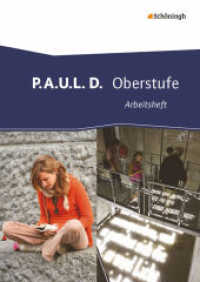Full Description
Written by esteemed social science research authors, this book encourages students to practice SPSS as they read about it, providing a practical, hands-on introduction to conceptualization, measurement, and association through active learning. This fully revised workbook will guide students through step-by-step instruction on data analysis using the latest version of SPSS and the most up to date General Social Survey data. Arranged to parallel most introductory research methods texts, this text starts with an introduction to computerized data analysis and the social research process, then walks readers step-by-step through univariate, bivariate, and multivariate analysis using SPSS Statistics. In this revised edition, active and collaborative learning will be emphasized as students engage in a series of practical investigative exercises.New to this edition:The text is fully updated to include screenshots and instructions for the latest release of SPSSReflects the most current GSS data, ensuring that students are exposed to the most current data availableAll exercises are fully compatible with SPSS Student Version 22, which can be bundled with the textCh. 15 (Tests of Significance) has been divided into two shorter, more manageable chapters, furthering student comprehension
Contents
Part IChapter 1: Introduction: The Theory and Practice of Social ResearchOverviewWhy Use a Computer?SPSS StatisticsSocial Research: A PrimerTheories and Concepts: Deprivation TheoryHypotheses and Variables: ReligiositySocial Research Strategies: Inductive and DeductiveTheory and Research in PracticeConclusionMain PointsKey TermsReview QuestionsChapter 2: The Logic of MeasurementValidity ProblemsReliability ProblemsDistinguishing Between Validity and ReliabilityMultiple IndicatorsLevels of MeasurementMeasurement and InformationMeasurement OptionsClassifying Variables as Discrete or ContinuousConclusionMain PointsKey TermsReview QuestionsChapter 3: Description of Data Sets: The General Social SurveySamplingData CollectionThe Codebook: Appendix AConclusionMain PointsKey TermsReview QuestionsPart II: Univariate AnalysisChapter 4: Using SPSS Statistics: Some BasicsDemonstration 4.1: Starting an SPSS Statistics SessionDemonstration 4.2: Exploring the Data View Portion of the Data EditorDemonstration 4.3: Entering Data- A PreviewDemonstration 4.4: Loading a Data SetDemonstration 4.5: Raw Data in Data ViewFinding Variable Information: Values and LabelsDemonstration 4.6: Variable View TabDemonstration 4.7: Ending Your SPSS Statistics SessionConclusionMain PointsKey TermsSPSS Statistics Commands Introduced in This ChapterReview QuestionsSPSS Statistics Lab Exercise 4.1Chapter 5: Describing Your Data: ReligiosityDemonstration 5.1: Opening Frequently Used Data FilesDemonstration 5.2: Setting Options-Variable Lists and Output LabelsDemonstration 5.3: Frequency DistributionsDemonstration 5.4: Frequency Distributions-Running Two or More Variables at One TimeDescriptive Statistics: Basic Measures of Central Tendency and DispersionDemonstration 5.5: The Frequencies ProcedureDemonstration 5.6: The Descriptives Procedure-Calculating Descriptive Statistics for Continuous VariablesDemonstration 5.7: Printing Your Output (Viewer)Demonstration 5.8: Adding Headers/Footers and Titles/TextDemonstration 5.9: Saving Your Output (Viewer)Demonstration 5.10: Saving Changes to Your Data SetConclusionMain PointsKey TermsSPSS Statistics Commands Introduced in This ChapterReview QuestionsSPSS Statistics Lab Exercise 5.1Chapter 6: Presenting Your Data in Graphic Form: Political OrientationsGraphing Data With Direct "Legacy" DialogsDemonstration 6.1: Frequency Table-POLVIEWSDemonstration 6.2: SPSS Statistics Chart EditorDemonstration 6.3: Frequency Table-PARTYIDDemonstration 6.4: Political AttitudesDemonstration 6.5: Histogram-AGEDemonstration 6.6: Line Chart-INCOMESaving and Printing Your ChartsConclusionMain PointsKey TermsSPSS Statistics Commands Introduced in This ChapterReview QuestionsSPSS Statistics Lab Exercise 6.1Chapter 7: Recoding Your Data: Religiosity and Political OrientationsDemonstration 7.1: Modifying Variables With Recode-ATTEND (R) CHATTDemonstration 7.2: Recoding AGE (R) AGECATDemonstration 7.3: Recoding POLVIEWS (R) POLRECDemonstration 7.4: Recoding PARTYID (R) PARTYDemonstration 7.5: Saving Changes to Your Data SetConclusionMain PointsKey TermsSPSS Statistics Commands Introduced in This ChapterReview QuestionsSPSS Statistics Lab Exercise 7.1Chapter 8: Creating Composite Measures: Exploring Attitudes Toward Abortion in More DepthDemonstration 8.1: Identifying the Seven Abortion Variables-File InfoDemonstration 8.2: Running Frequencies for Several Variables at OnceIndex: A Form of Composite MeasureDemonstration 8.3: ABORT IndexDemonstration 8.4: Defining ABORTDemonstration 8.5: Checking New Index-Comparing Scores on Old and New VariablesDemonstration 8.6: Running Frequencies for ABORTDemonstration 8.7: ABINDEXDemonstration 8.8: Running FrequenciesConclusionMain PointsKey TermsSPSS Statistics Commands Introduced in This ChapterReview QuestionsSPSS Statistics Lab Exercise 8.1Chapter 9: Suggestions for Further AnalysisDesired Family SizeDemonstration 9.1: Respondents' Ideal Family Size (CHLDIDEL)Child TrainingDemonstration 9.2: Important Qualities for ChildrenAttitudes About Sexual BehaviorDemonstration 9.3: Index of Sexual PermissivenessPrejudiceConclusionMain PointsKey TermsSPSS Statistics Commands Introduced in This ChapterReview QuestionsSPSS Statistics Lab Exercise 9.1Part III: Bivariate AnalysisChapter 10: Examining the Sources of ReligiosityThe Deprivation Theory of ReligiosityTesting Our Hypothesis: Correlating Religiosity and GenderDemonstration 10.1: Running Crosstabs to Test Our HypothesisDemonstration 10.2: Interpreting a Crosstab With Limited CategoriesDemonstration 10.3: Correlating Another Measure of Religiosity and GenderDrawing Conclusions Carefully: Reassessing Our Original HypothesisDemonstration 10.4: Interpreting a Crosstab With Ordinal Variables-Religiosity and AgeInterpreting Crosstabs With Ordinal VariablesDemonstration 10.5: Correlating Other Measures of Religiosity and AgeConclusionMain PointsKey TermsSPSS Statistics Commands Introduced in This ChapterReview QuestionsSPSS Statistics Lab Exercise 10.1Chapter 11: Political Orientations as Cause and EffectThe Relationship Between POLVIEWS and PARTYIDDemonstration 11.1: POLREC by PARTYDemonstration 11.2: PARTY by POLRECDemonstration 11.3: POLREC by AGECATDemonstration 11.4: PARTY by AGECATDemonstration 11.5: POLREC by RELIGDemonstration 11.6: PARTY by RELIGDemonstration 11.7: PARTY and POLREC by SEXDemonstration 11.8: POLREC by RACEDemonstration 11.9: PARTY by RACEDemonstration 11.10: Recoding EDUC (R) EDCATDemonstration 11.11: POLREC by EDCATDemonstration 11.12: PARTY by EDCATSome Surprises: Class, Marital Status, and PoliticsThe Impact of Party and Political PhilosophySaving Recoded Variable: EDCATConclusionMain PointsKey TermsSPSS Statistics Commands Introduced in This ChapterReview QuestionsSPSS Statistics Lab Exercise 11.1Chapter 12: What Causes Different Attitudes Toward Abortion?Demonstration 12.1: Gender and AbortionDemonstration 12.2: Age and AbortionDemonstration 12.3: Religion and AbortionDemonstration 12.4: Politics and AbortionDemonstration 12.5: Sexual Attitudes and AbortionOther Factors You Can Explore on Your OwnConclusionMain PointsKey TermsSPSS Statistics Commands Introduced in This ChapterReview QuestionsSPSS Statistics Lab Exercise 12.1Chapter 13: Measures of Association for Nominal and Ordinal VariablesThe Logic of Statistical Association: Proportionate Reduction of ErrorLambda (l): A Measure Appropriate for Nominal VariablesDemonstration 13.1: Instructing SPSS Statistics to Calculate Lambda (l)Interpreting Lambda and Other MeasuresGamma (g): A Measure Appropriate for Ordinal VariablesDemonstration 13.2: Instructing SPSS Statistics to Calculate Gamma (g)-Example 1Demonstration 13.3: Running Gamma (g)-Example 2 (Reverse Scoring Case)Additional Measures of AssociationAnalyzing the Association Between Variables at Different Levels of MeasurementConclusionMain PointsKey TermsSPSS Statistics Commands Introduced in This ChapterReview QuestionsSPSS Statistics Lab Exercise 13.1Chapter 14: Correlation and Regression AnalysisPearson's r: A Measure Appropriate for Interval/Ratio VariablesInterpreting Pearson's r and the Coefficient of Determination (r2)Instructing SPSS Statistics to Calculate Pearson's rDemonstration 14.1: Recoding RINCOM06 (R) RECINCDemonstration 14.2: Using SPSS Statistics to Compute Pearson's rDemonstration 14.3: Requesting Several Correlation CoefficientsRegression AnalysisDemonstration 14.4: RegressionDemonstration 14.5: Presenting Data Graphically-Producing a Scatterplot With a Regression LineAn Indication of Direction and Strength of AssociationMeasures of Association for Interval and Ratio VariablesAnalyzing the Association Between Variables at Different Levels of MeasurementConclusionMain PointsKey TermsSPSS Statistics Commands Introduced in This ChapterReview QuestionsSPSS Statistics Lab Exercise 14.1Chapter 15: Tests of SignificanceStatistical SignificanceSignificance Tests: Part of the Larger Body of Inferential StatisticsStatistical Significance Versus Measures of AssociationChi-Square (c2)Demonstration 15.1: Instructing SPSS Statistics to Calculate Chi-SquareSignificance and AssociationDemonstration 15.2: Instructing SPSS Statistics to Run Independent-Samples t TestDemonstration 15.3: t Test-EDUC by SEXAnalysis of VarianceDemonstration 15.4: Instructing SPSS Statistics to Run ANOVAA Statistical Toolbox: A SummaryConclusionMain PointsKey TermsSPSS Statistics Commands Introduced in This ChapterReview QuestionsSPSS Statistics Lab Exercise 15.1Chapter 16: Suggestions for Further Bivariate AnalysesDemonstration 16.1: Desired Family SizeDemonstration 16.2: Investigating Sexual Permissiveness FurtherAdditional ResourcesConclusionMain PointsKey TermsSPSS Statistics Commands Introduced in This ChapterReview QuestionsSPSS Statistics Lab Exercise 16.1Part IV: Multivariate AnalysisChapter 17: Multiple Causation: Examining Religiosity in Greater DepthMultiple CausationDemonstration 17.1: The Impact of Age and Sex on ReligiosityDemonstration 17.2: Family Status and ReligiosityDemonstration 17.3: Family Status and Religiosity, Controlling for AgeDemonstration 17.4: Social Class and ReligiosityOther Variables to ExploreChi-Square and Measures of AssociationRecoding SEX to Create a Dummy Variable: MALERecoding RACE to Create a Dummy Variable: WHITEMultiple RegressionConclusionMain PointsKey TermsSPSS Statistics Commands Introduced in This ChapterReview QuestionsSPSS Statistics Lab Exercise 17.1Chapter 18: Dissecting the Political FactorPolitical Philosophy and Party IdentificationDemonstration 18.1: Controlling for EducationDemonstration 18.2: The Mystery of Politics and Marital StatusConclusionMain PointsKey TermsSPSS Statistics Commands Introduced in This ChapterReview QuestionsSPSS Statistics Lab Exercise 18.1Chapter 19: A Powerful Prediction of Attitudes Toward AbortionReligion and AbortionDemonstration 19.1: Religious Affiliation and Church AttendanceDemonstration 19.2: Religious Affiliation, Church Attendance, and AbortionPolitics (POLREC, PARTY) and Abortion (ABORT)Demonstration 19.3: The Interaction of Religion and Politics on Abortion AttitudesDemonstration 19.4: Constructing an Index of Ideological TraditionalismSexual Attitudes and AbortionDemonstration 19.5: Recode PREMARSX and HOMOSEXDemonstration 19.6: The Relationship Between Sexual Permissiveness and INDConclusionMain PointsKey TermsSPSS Statistics Commands Introduced in This ChapterReview QuestionsSPSS Statistics Lab Exercise 19.1Chapter 20: Suggestions for Further Multivariate AnalysesIdeal Family Size and AbortionChild TrainingThe Protestant EthicCapital Punishment, Gender, and RaceDemonstration 20.1: CAPPUN by SEXDemonstration 20.2: CAPPUN by SEX, Controlling for RACEConclusionMain PointsKey TermsSPSS Statistics Commands Introduced in This ChapterReview QuestionsSPSS Statistics Lab Exercise 20.1Part V: The Adventure ContinuesChapter 21: Designing and Executing Your Own SurveyThe Social Research Process and ProposalDesigning and Executing Your Own SurveyGetting Ready for Data Analysis Using SPSS StatisticsDemonstration 21.1: Example 1-Defining IDDemonstration 21.2: Example 2-Defining CHLDIDELDemonstration 21.3: Copying a VariableDemonstration 21.4: Saving Your New FileDemonstration 21.5: Accessing File Information for Coding and EditingDemonstration 21.6: Moving Through Data ViewDemonstration 21.7: Entering DataDemonstration 21.8: Revising or Deleting DataDemonstration 21.9: Saving Your Data FileWriting a Research ReportConclusionMain PointsKey TermsSPSS Statistics Commands Introduced in This ChapterReview QuestionsSPSS Statistics Lab Exercise 21.1Chapter 22: Further Opportunities for Social ResearchThe Unabridged GSSOther Data SetsOther Computer ProgramsConclusionMain PointsKey TermsSPSS Statistics Commands Introduced in This ChapterReview QuestionsAppendix A: The CodebookAppendix B: Questionnaire for Class SurveyIndex/Glossary







